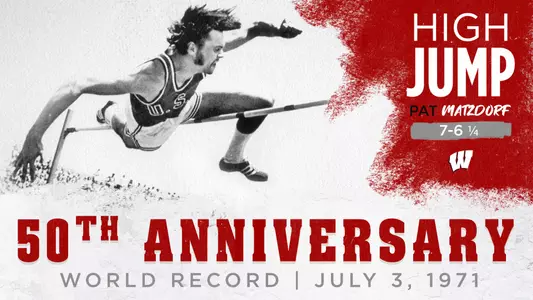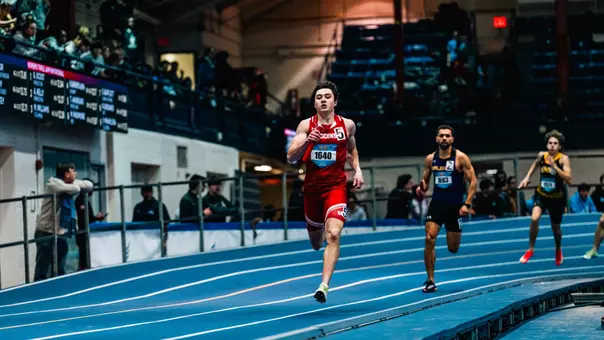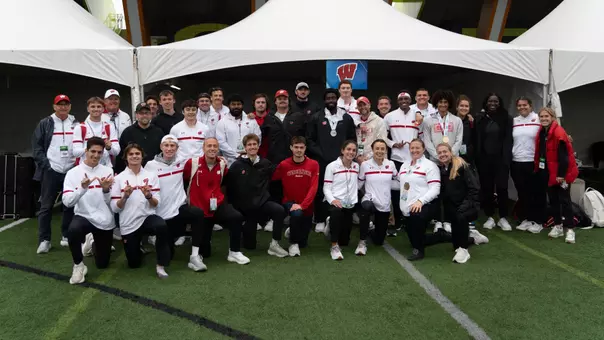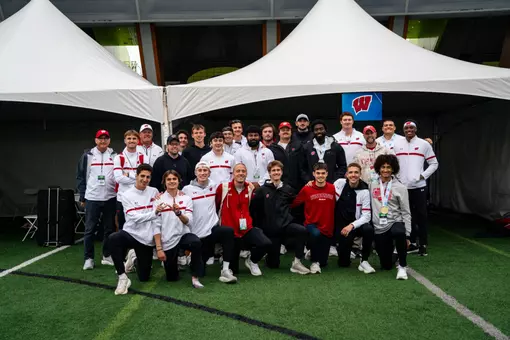
50 years ago: A world record for Matzdorf
July 02, 2021 | Men's Track & Field
Catching up with Badger pioneer
MADISON, Wis. – Fifty years ago today, Pat Matzdorf, a junior on the Wisconsin men's track and field team, became the first and only Badger to set a world record. The Sheboygan native was competing in the high jump at the World All-Star Meet featuring the USA vs. USSR in Berkeley, California, on July 3, 1971.
Before the meet, the 6-foot-2 Matzdorf had a personal best of 7 feet, 3 inches. He equaled that during the meet before going for the American record of 7-4 1/2, which he cleared on his second try. The world record was 7-5 ¾ set by Russian Valery Brumel at the very same meet in 1963. The bar was moved to 7-6 1/4, a height Matzdorf cleared on his third attempt.Gallery: (7-3-2021) 50th anniversary of Matzdorf high jump
Following his world record, Matzdorf was inundated with interview requests from the New York Times to his hometown Sheboygan Press. He was honored in his hometown with a parade as well as the city marking his world record height on street light poles.
Matzdorf, a 1972 graduate of Wisconsin with a degree in mathematics as well as a 1977 master's degree in computer science, carried his athletic success into his work. He was part of the team that developed software for the first commercial cellular phone system.
In honor of the 50th anniversary of his world record, UWBadgers.com caught up with Matzdorf.
After 50 years, what do you remember most about that day?
"First of all, I remember reading through the program the evening before the meet, the history of the USA vs. USSR dual meets and all of the rivalries, especially between John Thomas and Valery Brumel in the high jump.
"I was proud to be representing the USA in this prestigious meet, and as I warmed up that day, I felt the adrenalin. My early jumps at the lower heights felt so effortless that I wondered if the officials had mis-measured."
You set the record using the straddle form. Was that the common technique of the time? You also switched to the flop later in your career. How was the change for you?
"The most common technique at that time was still the straddle, but since Dick Fosbury popularized the flop at the 1968 Olympics, most of the younger jumpers were using the flop. In fact, one of the Russian jumpers at that meet used the flop.
"I switched to the flop in 1974 after I discovered that I didn't experience the same knee pain that I was having with the straddle. The switch was fairly quick and easy for me. I jumped 6-10 the first time I tried it, although it was rather ragged. Over time, I smoothed out my approach and technique and was consistently jumping over 7 feet, with a best of 7-4 1/4 in 1975."
What do you remember after setting the world record and the attention you received?
"There was certainly a lot of attention, many requests for interviews, and it felt like the spotlight was always on me. At meets, I felt like I now needed to consistently perform at a higher level."
Your record was broken by 19-year old Dwight Stones about two years later. What was your feeling when your record was broken?
"As they say, records are made to be broken. Also, I'm more of an introvert, so I felt somewhat relieved, hoping that the spotlight would now be redirected to Dwight. I wanted to be able to train and compete without distractions and added pressures."
You are the only Badger athlete to set a world record. Why do you think it happened to you when you look at all of other great athletes at the UW?
"First of all, I felt very fortunate to be surrounded by great coaches and teammates. We had strong teams at that time and I was always driven to contribute my part to help the team. When Bob Brennen brought in Bill Perrin as field events coach at the beginning of my sophomore year, he introduced me to a regimented training program, film study, and technical analysis and improvements. I owe a lot to his training and coaching. With that said, a world record is a pretty rare event, and everything has to come together at the right time and place. All I can say is that the stars where aligned for me that day."
The world record is now over eight feet. Are you surprised by that height?
"After the introduction of the flop, the high jump seemed to get a boost, with an influx of taller athletes that allowed them to utilize more speed that could be converted to greater heights. But eight feet is pretty amazing and that record has stood since 1993.
What were some of the other highlights of your UW career?
You won the Big Ten Medal of Honor, which is considered the conference's highest award, in 1971-72 for academic and athletic excellence. How were you able to be such a great student as well as a great athlete?
"Fortunately, there were only a few track meets during the season where we had to travel during the week and miss classes. Track practice began every day at 3:30 p.m., so I would just make sure that all of my classes ended before that time. I never skipped class and did the best I could because I wanted to graduate in four years."
You were part of the initial class inducted into the UW Athletic Hall of Fame in 1991. How did it feel to be recognized for your college accomplishments?
"It was a very special honor, especially considering the other athletes inducted at that time. It was made even better because my wife, children, and parents attended the ceremony."
You graduated with degrees in mathematics and computer science. How did your career as a Badger prepare you for your occupation?
"My academic career gave me a great foundation for a lifelong career in software development."
What was your occupation? Any major achievements in your occupation?
"I was a software developer, first at AT&T Bell Laboratories where I worked for 25 years. My most notable achievement was being on a team that developed the first cellular phone system that was initially deployed in the Chicago area in 1983.
"I continued to work in cellular development throughout my career at Bell Labs (later Lucent Technologies), where we continued to deliver higher capacity systems and new features. After leaving Bell Labs, I worked for a small startup company called Clarity that developed location-based applications for cell phones. Lastly, I worked at a company called Arris that developed internet routers and modems for the cable industry."
Talk about your family. What are they doing now?
"My wife Peggy and I live in Naperville, Illinois. We're both retired now. Peggy is an avid gardener and I'm on hand to assist with any heavy lifting. My primary hobby is golf where I've developed a love/hate relationship.
"Our son Dave and his wife live and work in Chicago where they enjoy the city way of life. Sadly, we lost our first daughter Alli to a drunk driver when she was 16. Our youngest daughter Sarah and her husband live on the north side of Indianapolis where they're raising our two grandchildren.
What do you enjoy doing now?
"Peggy and I enjoy spending time with our kids and grandkids. We enjoy traveling, especially love visiting the National Parks. When around here, we take long walks in the Morton Arboretum. Around the house, Peggy spends a lot of time in her gardens, while I venture out to yet another golf course."
Before the meet, the 6-foot-2 Matzdorf had a personal best of 7 feet, 3 inches. He equaled that during the meet before going for the American record of 7-4 1/2, which he cleared on his second try. The world record was 7-5 ¾ set by Russian Valery Brumel at the very same meet in 1963. The bar was moved to 7-6 1/4, a height Matzdorf cleared on his third attempt.
"On the third attempt, I just wanted to be as consistent as on the first two," Matzdorf said. "And then right at takeoff, something didn't seem right, like I didn't have the same rhythm, like I had been kind of abrupt with it. But I carried it through and slid over. I was really shocked. I didn't think I had a prayer. I hit the pad and flopped, and when I saw it had stayed up I instantly jumped up and held my hands over my head. I couldn't believe it." (from Great Moment in Wisconsin Sports by Todd Mishler)
Following his world record, Matzdorf was inundated with interview requests from the New York Times to his hometown Sheboygan Press. He was honored in his hometown with a parade as well as the city marking his world record height on street light poles.
Matzdorf, a 1972 graduate of Wisconsin with a degree in mathematics as well as a 1977 master's degree in computer science, carried his athletic success into his work. He was part of the team that developed software for the first commercial cellular phone system.
In honor of the 50th anniversary of his world record, UWBadgers.com caught up with Matzdorf.
After 50 years, what do you remember most about that day?
"First of all, I remember reading through the program the evening before the meet, the history of the USA vs. USSR dual meets and all of the rivalries, especially between John Thomas and Valery Brumel in the high jump.
"I was proud to be representing the USA in this prestigious meet, and as I warmed up that day, I felt the adrenalin. My early jumps at the lower heights felt so effortless that I wondered if the officials had mis-measured."
You set the record using the straddle form. Was that the common technique of the time? You also switched to the flop later in your career. How was the change for you?
"The most common technique at that time was still the straddle, but since Dick Fosbury popularized the flop at the 1968 Olympics, most of the younger jumpers were using the flop. In fact, one of the Russian jumpers at that meet used the flop.
"I switched to the flop in 1974 after I discovered that I didn't experience the same knee pain that I was having with the straddle. The switch was fairly quick and easy for me. I jumped 6-10 the first time I tried it, although it was rather ragged. Over time, I smoothed out my approach and technique and was consistently jumping over 7 feet, with a best of 7-4 1/4 in 1975."
What do you remember after setting the world record and the attention you received?
"There was certainly a lot of attention, many requests for interviews, and it felt like the spotlight was always on me. At meets, I felt like I now needed to consistently perform at a higher level."
Your record was broken by 19-year old Dwight Stones about two years later. What was your feeling when your record was broken?
"As they say, records are made to be broken. Also, I'm more of an introvert, so I felt somewhat relieved, hoping that the spotlight would now be redirected to Dwight. I wanted to be able to train and compete without distractions and added pressures."
You are the only Badger athlete to set a world record. Why do you think it happened to you when you look at all of other great athletes at the UW?
"First of all, I felt very fortunate to be surrounded by great coaches and teammates. We had strong teams at that time and I was always driven to contribute my part to help the team. When Bob Brennen brought in Bill Perrin as field events coach at the beginning of my sophomore year, he introduced me to a regimented training program, film study, and technical analysis and improvements. I owe a lot to his training and coaching. With that said, a world record is a pretty rare event, and everything has to come together at the right time and place. All I can say is that the stars where aligned for me that day."
The world record is now over eight feet. Are you surprised by that height?
"After the introduction of the flop, the high jump seemed to get a boost, with an influx of taller athletes that allowed them to utilize more speed that could be converted to greater heights. But eight feet is pretty amazing and that record has stood since 1993.
What were some of the other highlights of your UW career?
- Winning the 1970 Big Ten Indoor championship
- Winning the 1970 NCAA Outdoor Championship
- Jumping 7-3 to win the 1971 Big Ten Indoor Championship, which tied the American indoor record
- Winning the NCAA Indoor Championship in 1971
- Winning the 1971 Big Ten Outdoor Championship
- Pan American Games gold medalist in 1971
You won the Big Ten Medal of Honor, which is considered the conference's highest award, in 1971-72 for academic and athletic excellence. How were you able to be such a great student as well as a great athlete?
"Fortunately, there were only a few track meets during the season where we had to travel during the week and miss classes. Track practice began every day at 3:30 p.m., so I would just make sure that all of my classes ended before that time. I never skipped class and did the best I could because I wanted to graduate in four years."
You were part of the initial class inducted into the UW Athletic Hall of Fame in 1991. How did it feel to be recognized for your college accomplishments?
"It was a very special honor, especially considering the other athletes inducted at that time. It was made even better because my wife, children, and parents attended the ceremony."
You graduated with degrees in mathematics and computer science. How did your career as a Badger prepare you for your occupation?
"My academic career gave me a great foundation for a lifelong career in software development."
What was your occupation? Any major achievements in your occupation?
"I was a software developer, first at AT&T Bell Laboratories where I worked for 25 years. My most notable achievement was being on a team that developed the first cellular phone system that was initially deployed in the Chicago area in 1983.
"I continued to work in cellular development throughout my career at Bell Labs (later Lucent Technologies), where we continued to deliver higher capacity systems and new features. After leaving Bell Labs, I worked for a small startup company called Clarity that developed location-based applications for cell phones. Lastly, I worked at a company called Arris that developed internet routers and modems for the cable industry."
Talk about your family. What are they doing now?
"My wife Peggy and I live in Naperville, Illinois. We're both retired now. Peggy is an avid gardener and I'm on hand to assist with any heavy lifting. My primary hobby is golf where I've developed a love/hate relationship.
"Our son Dave and his wife live and work in Chicago where they enjoy the city way of life. Sadly, we lost our first daughter Alli to a drunk driver when she was 16. Our youngest daughter Sarah and her husband live on the north side of Indianapolis where they're raising our two grandchildren.
What do you enjoy doing now?
"Peggy and I enjoy spending time with our kids and grandkids. We enjoy traveling, especially love visiting the National Parks. When around here, we take long walks in the Morton Arboretum. Around the house, Peggy spends a lot of time in her gardens, while I venture out to yet another golf course."
Mick Byrne Media Conference || Wisconsin Track & Field || April 15, 2024
Monday, April 15
Mick Byrne Media Conference || Wisconsin Track & Field || Feb. 20, 2022
Monday, February 20
Mick Byrne Media Conference || Wisconsin Track & Field || February 22, 2021
Monday, February 22
UW Athletic Hall of Fame Class of 2020: Jeff Braun
Saturday, November 14













